Got Nature? Blog
Lenny Farlee, sustaining hardwood Extension specialist for Purdue’s Department of Forestry and Natural Resources (FNR), has been named a 2024 Fellow of the Society of American Foresters (SAF). The SAF Fellow Award, one of the highest honors bestowed on an SAF member by their peers, recognizes long-standing service to forestry at the local, state, regional and national levels.
Farlee was honored with the award during the 2024 SAF National Convention, which took place in Loveland, Colorado from Sept. 17-20.
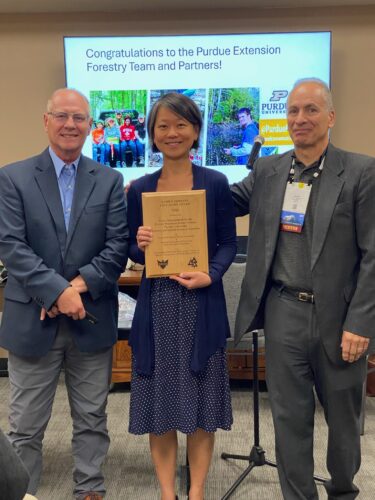
Zhao Ma accepts the 2024 Family Forests Education Award on behalf of Lenny Farlee and the other project team members.
“Being named a Fellow of the Society of American Foresters is particularly meaningful to me since it originates from a nomination by my peers at the state level,” Farlee said. “I am very grateful that my colleagues in forestry here in Indiana considered my service worthy of recognition, and I owe much of the credit to them for their support of me through my career. It has been my privilege to serve the people and the profession as an Extension forester here at Purdue.”
Farlee educates people about forestry in many ways, including through the popular Extension YouTube series “ID That Tree,” which has over 100,000 views.
Farlee was also recognized at the convention with the 2024 Family Forests Education Award. The National Woodland Owners Association (NWOA) and the National Association of University Forestry Resources Programs (NAUFRP) gave an award to Farlee, project lead, and his team for their course “Forest Management for the Private Woodland Owner.”
Farlee, Ronald Rathfon, Don Carlson, Jonathan Ferris, Dave Osborne and Phil Woolery worked together to develop the course. The course introduces forest landowners to the biology and management of forests and what resources and professional assistance are available. According to survey results from 2021 participants, “94.4% stated that the information was useful to help them make future decisions and 92.5% stated that the information was useful to help act to manage their property objectives.”
“We in FNR, along with forestry professionals in Indiana and the landowners who have communicated with Lenny and his colleagues through the ‘Forest Management for the Private Woodland Owner’ course, know how valuable this program has been to sustainable forest management in Indiana,” said Zhao Ma, interim department head and professor of forestry and natural resources. “So it is absolutely wonderful when others outside of our FNR community and beyond Indiana also recognize the excellent work that Lenny and his colleagues have been doing…, I would also like to share one more note about Lenny – not only has Lenny been a highly valued and respected member of FNR and the forestry profession for many years, but he is also one of the nicest people I have met. He is knowledgeable yet humble, effective yet gentle, serious about his work yet able to have fun, very busy yet always willing to help others and try to be present. We are lucky to have Lenny as our colleague in FNR.”
To view this article along with other news and stories posted on the Purdue Forestry and Natural Resources website view: Purdue FNR Extension specialist receives national recognition for work in forestry
Resources:
ID That Tree – Video Playlist, Purdue Extension – Forestry and Natural Resources (FNR) YouTube Channel
Purdue Arboretum Explorer
Conservation Tree Planting: Steps to Success, Purdue Extension – FNR YouTube Channel
A Woodland Management Moment, Playlist, Purdue Extension – FNR YouTube Channel
Woodland Stewardship for Landowners, Playlist, Purdue Extension – FNR YouTube Channel
Indiana Department of Natural Resources: Invasive Species
Indiana Invasive Species Council
Cooperative Invasive Species Management Area (CISMA)
Report Invasive, Purdue Extension
Shrubs and Woody Vines of Indiana and the Midwest, The Education Store
Native Trees of the Midwest, The Education Store
Professional Forester, Indiana Forestry Woodland Owners Association
Forest Improvement Handbook, The Education Store
Find an Arborist, International Society of Arboriculture
Purdue University Department of Forestry and Natural Resources
Morning AgClips — Nestled within the cool, flowing waters of Indiana’s Blue River, the elusive hellbender thrives under big, flat rocks, seeking refuge from predators and finding the perfect conditions to lay their eggs. But in recent years, they have become increasingly difficult to find.
Morning AgClips interviews Purdue hellbender team for details regarding Farmers Helping Hellbenders Project, aimed at restoring Indiana’s endangered hellbender salamander population by improving water quality in the Blue River-Sinking watershed. Learn more about this initiative by hearing directly from the people involved, with the two overarching goals being about improving hellbender habitat and also enhancing local farming operations. Particularly, the project engages farmers in adopting sustainable practices as well, while strengthening conservation efforts for hellbenders.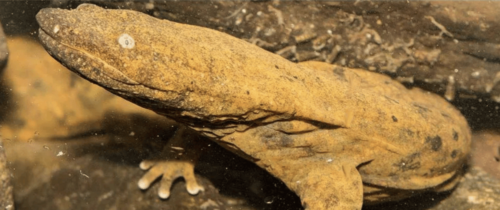
Hellbenders used to have a much larger range, occurring in most of southeast Indiana’s tributaries to the Ohio River and in the Wabash River. Sadly, its population has dropped drastically due to modification of stream habitats including the accumulation of sediment, agricultural and industrial pollution, warming waters and the channelization of streams and rivers. Because of their decline, these endangered ancient amphibians, with their large, unique flat bodies, have become the focus of an ambitious conservation effort led by Purdue University.
“The significance of the hellbender and its conservation extends beyond the species itself,” Purdue Extension Wildlife Specialist, Nick Burgmeier explains. “Hellbenders are an indicator species; their presence reflects the health of the water quality. Historically common and a top predator in streams, their decline has ecological repercussions, particularly on crayfish populations, which can disrupt food webs.”
Read more on the Morning AgClips website at Rebuilding Indiana’s Hellbender Habitat.
Resources:
Farmers Helping Hellbenders RCPP Program Accepting Applications, Purdue Forestry and Natural Resources News
USDA Awards Farmers Helping Hellbenders Project in Funding, Purdue Extension – Forestry and Natural Resources (FNR) Got Nature? Blog
Improving Water Quality by Protecting Sinkholes on Your Property, Purdue Extension – FNR YouTube Channel
Improving Water Quality Around Your Farm video, Purdue Extension – FNR YouTube Channel
Adaptations for Aquatic Amphibians, The Education Store, Purdue Extension’s resource center
Hellbenders Rock! Nature of Teaching Lesson Plan, The Education Store
Nature of Teaching – Hellbenders Rock Sneak Peek video, Purdue Extension – FNR YouTube Channel
Nature of Teaching – Hellbenders Rock webinar video, Purdue Extension – FNR YouTube Channel
Learn about hellbenders and take a tour of Purdue’s hellbender rearing facility video, Purdue Extension – FNR YouTube Channel
Learn about the hellbender work at Mesker Park Zoo video, Purdue FNR Facebook
Learn about hellbender work at The Wilds video, Purdue FNR Facebook
Dr. Rod Williams’ 2017 TEDx Talk Help the Hellbenders video, Purdue Extension – FNR YouTube Channel
A Moment in the Wild – Hellbender Hides video, Purdue Extension – FNR YouTube Channel
A Moment in the Wild – Hellbender Release video , Purdue Extension – FNR YouTube Channel
Morning AgClips
The summer issue of the Purdue Alumnus magazine highlights Gabrielle Sjoberg, FNR 2008, and the Nature of Teaching. The section titled “The Nature of Well-Being” shares how Boilermakers are making connections regarding the power of nature to improve our health, moods and thinking.
For Gabrielle Sjoberg (A’08), connecting people to nature has become her life’s work.
The wildlife science alumna, whose master’s degree in biology from Miami University focused on outdoor programming, has helped kids discover nature at the Indiana Dunes National Park, ran nature programs and camps at the Natural History Museum of Los Angeles County, and led youth conservation corps programs in Angoon, Alaska.
“I’m working with kids who, even though they’ve grown up in these remote wilderness areas, have not necessarily done much exploring in the bays and rivers,” says Gabrielle Sjoberg, FNR 2008.
The rural and Indigenous youths in the program work on projects such as clearing trails and fallen trees with program partners, including the United States Forest Service, and also help with the traditional seasonal harvesting, preservation, and distribution of foodstuffs that are crucial for locals: salmon, clams, moose, deer, herring eggs, blueberries, and beach asparagus.
For full article view, For Gabrielle Sjoberg (A’08), connecting people to nature has become her life’s work.
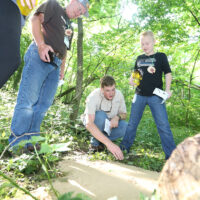 The Nature of Teaching
The Nature of Teaching
In 2005, when journalist Richard Louv published his groundbreaking book Last Child in the Woods: Saving Our Children from Nature-Deficit Disorder, research on the ways natural environments can benefit humans was just getting started.
The program’s three areas of focus—wildlife, food waste, and health and wellness—provide standards-based curricula along with suggestions for informal “field day” activities, all centered around getting kids outside.
The teachers said they needed training, good science-based lesson plans, and a repository of natural resource–related information they could easily access. In response, Dr. Rod Williams created a comprehensive professional development program for teachers called the Nature of Teaching, housed in the College of Agriculture’s Extension program.
Williams recently left Purdue for Texas Tech, where he serves as vice provost for outreach and engagement, but his legacy lives on in the Nature of Teaching program, which is now codirected by Veronica (Yager) Bullock (A’17) and Jarred Brooke (A’12), who is also an Extension wildlife specialist.
According to Bullock, who has taught many of the Nature of Teaching units as well as workshops for teachers, the lesson plans have been downloaded 400,000 times since the program’s launch. “That shows there’s a real interest in this,” she says.
For full article view, The Nature of Teaching.
The Nature of Teaching includes formal standards-based curricula and informal activity-based curricula all centered around getting youth outside. The three program areas of the formal curricula include: Wildlife, Health and Wellness, and Food Waste. Each program area provides standards-based lesson plans, available as free downloadable PDFs, which are classroom ready for grades K-12.
The Purdue Alumnus magazine, referred to as “Bulletin of the Purdue Alumni Association” in its early years, is the flagship publication of the Purdue for Life Foundation. It aims to inform, inspire and entertain readers through stories that provide insight into Purdue University and its initiatives, alumni, students, faculty and staff.
Resources:
Nature of Teaching, Connecting Youth With Nature for Health and Education, Agriculture Natural Resources, Got Nature? Blog Post
Virtual Workshops, Nature of Teaching
Nature of Teaching, Website, Purdue College of Agriculture
The Nature of Teaching, YouTube channel
Transporting Food Waste, The Education Store, Purdue Extension resource center
Benefits of Connecting with Nature, The Education Store
Nature of Teaching: Common Mammals of Indiana, The Education Store
The Nature of Teaching: Food Waste Solutions, The Education Store
The Nature of Teaching: Food Waste and the Environment, The Education Store
The Nature of Teaching: Trees of the Midwest, The Education Store
The Nature of Teaching: Adaptations for Aquatic Amphibians, The Education Store
Trees of the Midwest Webinar, Nature of Teaching YouTube channel
Adaptations For Aquatic Amphibians Webinar, Nature of Teaching YouTube channel
Agriculture & Natural Resources (ANR)
Diana Evans, Extension and Web Communication Specialist
Purdue University Department of Forestry and Natural Resources
Jarred Brooke, Wildlife Extension Specialist
Purdue Department of Forestry and Natural Resources
Veronica Bullock, ANR Extension Educator
Purdue Extension Franklin County
Purdue Landscape Report: August was National Check Your Tree Month, but this is something that every tree owner/manager should be doing year-round. As the last hot days of summer are finishing up and we look forward to cooler fall days, we can look to our trees for different signs of trouble.
Most people tend to look up at the canopy before anything else in trees. Check leaves for dieback, discoloration, stickiness or signs of chewing. Check branches and the main stem for damage like splits and breaks, peeling bark, tunneling patterns under the bark, oozing wet spots, or sawdust around the tree. These could be signs of issues in the root system, pathogens like bacteria or fungal organisms, insect problems, or structural damage.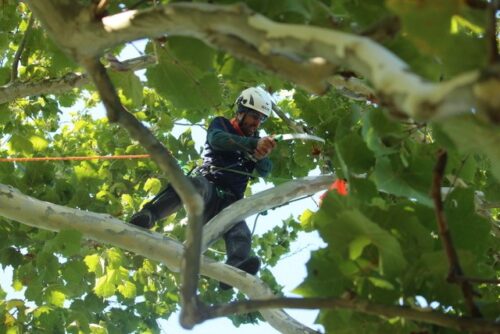
This is not an exhaustive list and if you notice these or anything else that seems off, it could be time for a deeper dive into what might be wrong. If you know the species of your tree the Purdue Plant Doctor is a great tool to narrow down a diagnosis. You can also contact your local Extension office or an ISA Certified Arborist.
On a more positive side, you don’t have to be on the lookout for damage, decline, or signs of pathogens and pests. It is also a matter of enjoying the trees in your landscape. Take some time out of your day to sit in the shade especially as we transition from hot summer temperatures into the cooling of autumn. Revel in the color changes as chlorophyll production slows revealing the carotenoids (that give us yellows, oranges, and browns) and anthocyanin (that produces reds and purples). In winter, not only can you better see damage in the canopy hidden by leaves in the growing seasons, but also the structure and architecture of the canopies in different tree species and the differences in bark textures. And in Spring, new growth of leaves and flowers shows us Winter is nearing its end, bringing warmer days.
So check your trees throughout the year. But not only for potential issues and risk management but also for enjoyment. Trees offer us no many benefits and sometimes it takes a little reminder. If you do see any signs of decline or damage, again, be sure to contact your local Extension office or an ISA Certified Arborist.
View the original article here: Enjoy Your Trees While Checking Them
Subscribe and receive the newsletter: Purdue Landscape Report Newsletter.
Resources:
Find an Arborist video, Trees are Good-International Society of Arboriculture (ISA)
Trees and Storms – The Education Store, Purdue Education’s resource center
Caring for storm-damaged trees/How to Acidify Soil in the Yard – In the Grow, Purdue Extension
Moist soil and rotten roots makes it easy for trees to come crashing down – Fox 59 News
Expert: Some storm damage can be easily prevented – Fox 59
Why Is My Tree Dying? – The Education Store
Tree Risk Management – The Education Store
Mechanical Damage to Trees: Mowing and Maintenance Equipment – The Education Store
Trees and Electric Lines – The Education Store
Tree Defect Identification, The Education Store
Planting Your Tree, video, The Education Store
Tree Installation, The Education Store
Tree Wound and Healing, Got Nature? Blog, Purdue Extension – Forestry and Natural Resources
Subscribe – Purdue Extension-FNR YouTube Channel
Ben McCallister, Urban Forestry Specialist
Purdue Forestry & Natural Resources
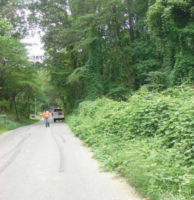
Photo by Division of Entomology & Plant Pathology, Indiana Department of Natural Resources.
Weekly Review, Division of Entomology & Plant Pathology, Indiana DNR: Will Drews, Indiana Department of Natural Resources (DNR) Nursery Inspector & Compliance Officer with the DNR Division of Entomology & Pathology shares in September Weekly Review e-newsletter how staff will continue to help coordinate kudzu control throughout the state and expands upon the state funded kudzu control program.
As some of you may know, kudzu (Pueraria montana var. lobata) is an invasive woody vine that can now be found throughout the state of Indiana. It is referred to colloquially as “the vine that ate the south,” and if you took a drive through some southern states (e.g. Tennessee, Georgia, the Carolinas, etc.) right now, you’d see why. Kudzu has tremendous growth potential, sometimes as much as 1 foot per day. Some vines reach lengths of up to 100 feet. Because of this it is a detriment to Indiana’s natural resources, kudzu has been listed as a prohibited invasive plant under the DNR’s Administrative Code as per 312 IAC 18-3-16 Control of kudzu.
While part of the language includes that the landowner “must take efforts to eliminate this species in such a manner as is consistent with federal and state law,” the Division of Entomology & Plant Pathology have been leading a state funded control program where sites are treated on a rotating, priority basis to eradicate or suppress further spread with no cost to the landowner. Over the last month, around 40 kudzu sites in Indiana have been treated and we have seen some great progress from last year.
If you think you have seen a new kudzu population, please send me that information (photos and GPS coordinates or address) at my email address provided below. A couple of the sites treated this year are new reports from last year that we were able to address. With your help, we can try to reduce the impact of this incredibly invasive vine and protect our natural resources.
For more information regarding this invasive vine Kudzu see the Indiana Department of Natural Resources, Division of Entomology & Plant Pathology, Kudzu.
Subscribe: Entomology Weekly Review.
Resources:
Indiana Department of Natural Resources-Division of Entomology & Plant Pathology
Indiana Department of Natural Resources-Natural Resources Conservation Service Plants Profile
Indiana Department of Natural Resources-National Invasive Species Information Center
Indiana Department of Natural Resources-Kudzu Alert & Identification Sheet
Indiana Department of Natural Resources-Kudzu Fact Sheet
Indiana Department of Natural Resources-Kudzu Before & After Treatment Photos
Invasive Species, Playlist, Purdue Extension – FNR YouTube Channel
Report Invasive Species, Purdue Invasive Species
What are invasive species and why should I care?, Got Nature? Blog, Purdue Extension – Forestry and Natural Resources
Indiana Department of Natural Resources: Invasive Species
Invasive Plant Species Identification, Video, Purdue Extension – FNR Youtube Channel
Mile-a-minute Vine, The Education Store
Invasive Plant Series: Swallow-worts, The Education Store
Will Drews, Nursery Inspector & Compliance Officer, Division of Entomology & Plant Pathology, WDrews@dnr.IN.gov
Indiana Department of Natural Resources (IN DNR)
Posted on September 4th, 2024 in
Forestry,
Wildlife,
Woodlands |
No Comments »MyDNR, Indiana’s Outdoor Newsletter: Hunters can apply for reserved hunts at on.IN.gov/reservedhunt, the one-stop information spot for the hunts. The online method is the only way to apply. No late entries will be accepted. Applicants must possess a hunting license that’s valid for the hunt for which they apply.
Applications must be submitted by 11:59 p.m. ET on Sunday, Sept. 15. More specific hunt information for individual properties is available on the website.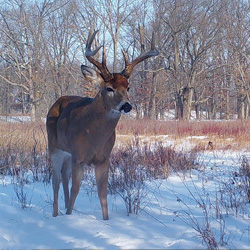
Hunters will be selected through a random computerized drawing. An email will be sent to all applicants when draws have been completed. Applicants will be able to view draw results online within two weeks after the application period closes.
Please note that only one application per hunt is allowed. No changes can be made once an application is submitted. The application process is now consolidated into the online services website along with licenses, CheckIN Game, and HIP registration. An online account is not required to apply, but a Customer ID number is needed.
In this system, hunts without a registration fee will follow the same process as those with a fee. Applicants must add a hunt to their cart and place an order to submit their application. If the transaction total is $0, the applicant will not be asked to enter credit card information.
Get more information at Reserved hunt applications open Aug. 19.
To subscribe to the newsletter visit MyDNR Email Newsletter.
Resources:
How to Score Your White-tailed Deer, video, The Education Store, Purdue Extension Resource Center
White-Tailed Deer Post Harvest Collection, video, The Education Store
Age Determination in White-tailed Deer, video, The Education Store
How to Build a Plastic Mesh Deer Exclusion Fence, The Education Store
Managing Your Woods for White-Tailed Deer, The Education Store
Bovine Tuberculosis in Wild White-tailed Deer, The Education Store
Help With Wild Turkey Populations, Video, Purdue Extension – Forestry and Natural Resources YouTube Channel
Turkey Brood Reporting, Indiana Department of Natural Resources (IDNR)
Wild Turkey, Indiana Department of Natural Resources (IDNR)
Wild Turkey Hunting Biology and Management, Indian Department of Natural Resources (IDNR)
Subscribe to Purdue Extension-Forestry & Natural Resources YouTube Channel, Wildlife Playlist
Indiana Department of Natural Resources, Department of Fish & Wildlife
Purdue Landscape Report: As summer comes to a close, plants are rapidly releasing seeds and the most noticeable are the flying fluffy type. Thistles, asters and milkweed are just a few of the summer-flowering plants that depend on the wind to disperse their seeds, sometimes carrying them miles away to potentially suitable locations, though seeds typically land within a few meters of the mother plant. This may not be a concern if it’s a desirable plant, but can become extremely problematic when that seed comes from Canada Thistle (Cirsium arvense) (Fig. 1).
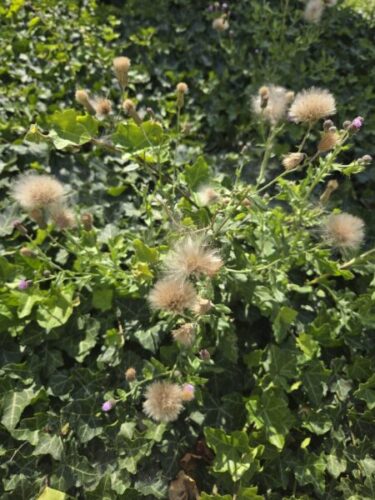
Figure 1. Canada thistle (Cirsium arvense), growing amongst common ivy (Hedera helix), produces a fluffy seed that is dispersed by wind.
Canada thistle is found on the list of Indiana Noxious Weeds (IC 15-16-7-2), which mandates that landowners take necessary steps to control and contain the spread of this highly invasive species. Formal enforcement of this Indiana Code falls to Township Trustees, though weed control is a responsibility that is often overlooked. Landowners and homeowners shouldn’t wait for a notice, or knock at the door, from a Township Trustee to begin controlling Canada thistle. It’s listed as a noxious weed for good reason.
Canada thistle is a perennial plant that can reproduce from seed or rhizomes making it difficult to control and contain. Each plant can produce thousands of wind-blown seeds that may remain viable for up to 20 years in the soil. Rhizomes are horizontal underground stems that can grow several feet and put out new shoots (Fig. 2). To add insult to injury, if a rhizome is cut or tilled, a separate plant may grow from each piece of rhizome.
Mechanical and cultural control options for Canada thistle are limited and may reduce plant density, but are not effective at eradicating large, established populations in a landscape. A new population, without an established root system, may be controlled with frequent mowing to deplete food reserves and prevent seed production.Small, isolated populations may be controlled with hand-pulling, but this will need to be repeated every few weeks.
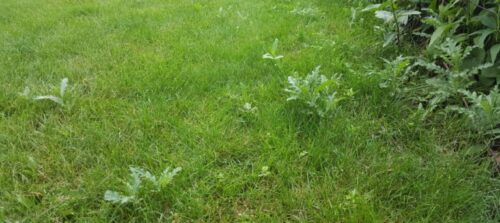
Figure 2. Canada thistle (Cirsium arvense) reproduces by growing horizontal underground stems called rhizomes. Rhizomes can send up new shoots several feet from the mother plant.
Chemical control options include pre- and post-emergent herbicides and, in many cases, applications of both types are needed for complete eradication. A pre-emergent herbicide, with an active ingredient of dichlobenil, is effective at preventing seed from germinating, but will not control established plants. A post-emergent herbicide with the active ingredient of clopyralid is the most effective option for home gardeners. Clopyralid is a selective herbicide for broadleaf weeds, but most vegetable and ornamental plants are susceptible. Precautions should be taken to avoid off-target damage. Read and understand the herbicide label before use. The label is the law.
Regardless of the method used, complete control of an established Canada thistle population will take persistence over multiple seasons. If the fluffy seed is beginning to fly from your thistle patch, it will likely take many more seasons to rid the garden of this pest, but it is possible. To win the battle against Canada thistle, it takes serious grit and an effective herbicide, or a good realtor.
View the original article here: What the Fluff?!
Subscribe and receive the newsletter: Purdue Landscape Report Newsletter.
Resources:
ID That Tree, Playlist, Purdue Extension – FNR YouTube Channel
Find an Arborist video, Trees are Good-International Society of Arboriculture (ISA)
A Woodland Management Moment, Playlist, Purdue Extension – FNR YouTube Channel (Against Invasives, Garlic Mustard, Autumn Olive)
Woodland Stewardship for Landowners, Playlist, Purdue Extension – FNR YouTube Channel (Common Buckthorn, Japanese Barberry)
Planting Your Tree, Video, The Education Store
Tree Installation, The Education Store
Indiana Invasive Species Council
Indiana Department of Natural Resources: Invasive Species
Purdue Extension Pond and Wildlife Management Website
Control of Canada Thistle in CRP and Other Noncrop Acreage, The Ed Store
Invasive Thistles
Report Invasive Species, Purdue Invasive Species
Understanding and Controlling Thistle in the Nursery and Landscape, Purdue Landscape Report
Subscribe – Purdue Extension-FNR YouTube Channel
Karen Mitchell, Consumer Horticulture Extension Specialist
Purdue Horticulture & Landscape Architecture
Explore the latest newsletter updates on the Indiana Woodland Steward website. Stay up-to-date with forestry news and receive their free e-newsletter by subscribing at IWS Subscribe.
Highlights from the new Newsletter include:
- An Interview with a Forester
by Dan Erst
- “Why did you pursue a forestry career? I was a young college kid and really had no idea where I would potentially spend the rest of my life…”
- The EQIP program promotes native plant diversity in Indiana forests
by Aubrey Franks
“Invasion by non-native shrubs has negatively affected forests throughout the eastern United States. The onslaught of invasive shrubs, including…”
- 2023 Outdoor Laboratory of the Year
by Ken Day
“Fishers Junior High School of Fishers, Indiana was selected as the 2023 Outdoor Laboratory of the Year. The award…”
- 2023 Indiana Tree Farmer of the Year
by Ken Day
“Jeffrey and Jeanna Stout of Hagerstown, Indiana are the 2023 Indiana Tree Farmers of the Year. Their tree farm is…”
- Deer Impact Toolbox: Helping Understand and Address Deer Impacts on Indiana Woodlands
by Jarred Brooke, Lenny Farlee, Elizabeth Jackson, Mike Jenkins, Caleb Redick, and Richard Sample
“When deer are overabundant, they negatively impact woodlands and forests in Indiana. Have you heard this statement before? Are deer having a negative…”
- The Birders’ Dozen Profile 9: Eastern Whip-poor-will – Dr. Jessica Outcalt, consulting bird biologist
by Dr. Jessica Outcalt, consulting bird biologist
“Welcome to the Birders’ Dozen! Over the next four issues we are going to continue introducing the last few birds from…”
- Enriching Log Landings to Benefit the Native Bees of Indiana
by Aliza Boles Fassler, Cheryl Coon, and Lauren Pile Knapp
“While everyone knows the European honey bee (Apis mellifera), many don’t know about the 430 species of native bees pollinating Indiana’s..”
- Technology Corner – Merlin Bird ID App
“Merlin features the best of community contributed photos, songs, and calls, tips from experts around the world to help you ID the birds you see…”
- Ask the Steward – Volume 2
By Dan Ernst
“Question: Are cicadas and locusts the same insect and are they edible?”
The Indiana Woodland Steward Newsletter is a resource offering a wealth of valuable information for foresters, woodland owners, timber marketing specialists, woodland and wildlife enthusiasts. The Indiana Woodland Steward Institute (IWS) is an entity made from 11 organizations within the state including Purdue University, Indiana Department of Natural Resources (DNR), and Indiana Hardwood Lumbermen’s Association (IHLA), that works to promote best usage practices of Indiana’s woodland resources through their Woodland Steward publication.
Resources
Hardwood Ecosystem Experiment – Wildlife Responses to Timber Harvesting, The Education Store, Purdue Extension resource center
Forest Improvement Handbook, The Education Store
Invasive plants: impact on environment and people, The Education Store
Managing Your Woods for White-Tailed Deer, The Education Store
Shrubs and Woody Vines of Indiana and the Midwest, The Education Store
Birds and Residential Window Strikes: Tips for Prevention, The Education Store
Breeding Birds and Forest Management: the Hardwood Ecosystem Experiment and the Central Hardwoods Region, The Education Store
Deer Impact Toolbox, The Education Store
Birdfeeder tips, The National Audubon Society
Managing Woodlands for Birds Video, Purdue Extension-Forestry and Natural Resources YouTube Channel
Subscribe: Deer, Forest Management, ID That Tree, Woodland Management Moment, Invasive Species and many other topic video playlists Purdue Extension-Forestry and Natural Resources YouTube Channel
Dan McGuckin, President
Indiana Woodland Steward
Dr. Brian MacGowan, Extension Wildlife Specialist
Department of Forestry & Natural Resources, Purdue University
Purdue Landscape Report: There have been a significant number of questions and problems regarding triclopyr that have come up this growing season.
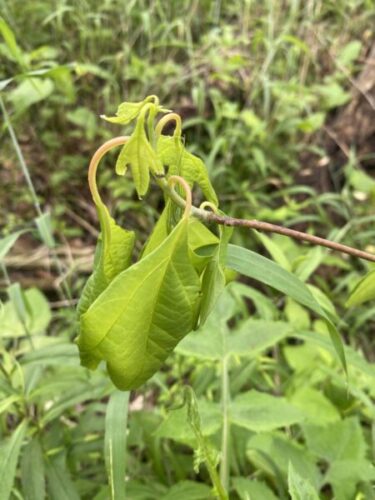
Figure 1. Confirmed damage from triclopyr on sassafras shows the growth regulator-type injury on leaves. Photo courtesy of the Office of the Indiana State Chemist.
Several of these problems have come through the Purdue Plant and Pest Diagnostic Laboratory from landscapers, nurseries, and property managers.
General Information about Triclopyr
Triclopyr is a selective systemic herbicide belonging to the pyridine class. It is primarily used to manage woody plants, vines, and some broadleaf weeds. Unlike glyphosate, a broad-spectrum herbicide, triclopyr specifically targets the growth hormones in dicotyledonous plants, making it effective in controlling species that are difficult to manage with other herbicides. It works by mimicking plant hormones, disrupting normal growth processes, and leading to the death of the treated plant (Fig. 1).
What Triclopyr Controls
Triclopyr is utilized in various settings to control unwanted vegetation. It is effective against species such as:
- Woody Plants: Includes trees like tree of heaven and callery pear and shrubs like autumn olive and honeysuckle (Fig. 2).
- Vines: Particularly those that can outcompete native flora, such as kudzu or English ivy (Fig. 3).
- Broadleaf Weeds: Some herbaceous plants that pose ecological or agricultural problems.

Figure 2. Invasive plants, such as, Pyrus calleryana (callery pear) can be controlled by triclopyr.

Figure 3. Invasive vines, such as Hedera helix (English ivy) can be controlled via multiple applications of triclopyr.
Where and When Triclopyr is Used
Triclopyr is applied in a range of environments, including:
- Forestry: To clear invasive species and manage forest regeneration.
- Agriculture: To control weeds and shrubs that interfere with crop production.
- Aquatic Areas: Formulations that are safe for aquatic environments help manage invasive species near water bodies.
- Rights-of-Way: To maintain clear paths and prevent the spread of invasive plants.
Timing of application is crucial. Triclopyr is most effective when applied during the growing season when plants are actively taking up nutrients and can transport the herbicide throughout their system.
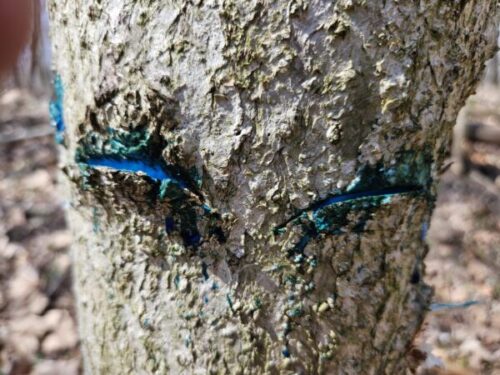
Figure 4. Hack and squirt treatments with triclopyr is a common method to control invasive trees. Photo by Lenny Farlee.
Movement in the Plant
Triclopyr is absorbed through foliage and roots and is translocated systematically within the plant. Once inside, it moves upward through the xylem and downward through the phloem (ambimobile). This systemic movement allows triclopyr to affect not just the treated areas but also parts of the plant that are not directly sprayed. This attribute makes it effective for managing large, established plants, specifically through hack and squirt treatments (Fig. 4).
For the full article and conclusion sharing how Triclopyr is a valuable tool for managing invasive and woody plants view: The Summer of Triclopyr: Mounting evidence for off-target damage.
Subscribe and receive the newsletter: Purdue Landscape Report Newsletter.
Resources:
Find an Arborist video, Trees are Good-International Society of Arboriculture (ISA)
ID That Tree, Playlist, Purdue Extension – FNR YouTube Channel
Invasive Species Playlist, Playlist, Purdue Extension – FNR YouTube Channel
A Woodland Management Moment, Playlist, Purdue Extension – FNR YouTube Channel (Against Invasives, Garlic Mustard, Autumn Olive)
Woodland Stewardship for Landowners, Playlist, Purdue Extension – FNR YouTube Channel (Common Buckthorn, Japanese Barberry)
Report Invasive Species, Purdue Invasive Species
The GLEDN Phone App – Great Lakes Early Detection Network
Invasive Plants of the Eastern U.S.: An Introduction to the Problematic Non-Native Species, The Education Store, Purdue Extension’s resource center
EDDMaps – Early Detection and Distribution Mapping System
Episode 11 – Exploring the challenges of Invasive Species, Habitat University-Natural Resource University
What Are Invasive Species and Why Should I Care?, Purdue Extension-FNR Got Nature? Blog
Emerald Ash Borer Information Network, Purdue University and Partners
Aquatic Invasive Species, Illinois-Indiana Sea Grant (IISG)
Invasive plants: impact on environment and people, The Education Store, Purdue Extension’s resource center
Subscribe Purdue Extension-Forestry and Natural Resources YouTube Channel
Kyle Daniel, Commercial Landscape and Nursery Crops Extension Specialist
Purdue Horticulture & Landscape Architecture
Posted on August 6th, 2024 in
Alert,
Forestry,
Wildlife |
No Comments »MyDNR, Indiana’s Outdoor Newsletter: Help DNR calculate harvest rates. July was dove banding season, when DNR bands mourning doves across the state. This important research effort helps estimate Indiana’s dove population and determine harvest limits for the hunting season. If you recover a banded bird, be sure to report it online. You’ll receive a certificate of appreciation that includes the bird’s information.
Mourning Dove Banding Program
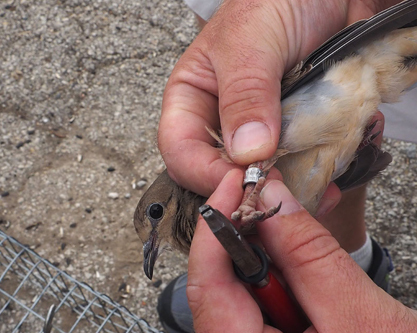 A national banding program was initiated in 2003 to improve our understanding of mourning dove population biology and to help estimate the effect of harvest on mourning dove populations. Doves are banded in July and August in most of the lower 48 states. Band recoveries occur almost exclusively during the U.S. hunting seasons which occur between 1 September and 31 January.
A national banding program was initiated in 2003 to improve our understanding of mourning dove population biology and to help estimate the effect of harvest on mourning dove populations. Doves are banded in July and August in most of the lower 48 states. Band recoveries occur almost exclusively during the U.S. hunting seasons which occur between 1 September and 31 January.
Otis, D.L. 2009. Mourning dove banding needs assessment. U.S. Fish and Wildlife Service. Unpublished report. 22pp.
Mourning Dove Population Status Report Library Collection
Reporting Banded Birds
If you have found or harvested a banded bird, please report it at www.reportband.gov. You’ll need the band number, or numbers, if the bird has more than one band. See below for more information on reward bands. You’ll also need to know where, when and how you recovered the bird. Your contact information will be requested in case there are any questions. The U.S. Geological Survey Bird Banding Lab (BBL) will send you a certificate of appreciation that includes information about the sex, age and species of the bird, and where and when it was banded. You can keep the band. Please note: Even if the band you recover is inscribed with a 1-800 telephone number, as of July 2, 2017, you can only report it at www.reportband.gov.
If some or all of the numbers have worn off, making the band unreadable, please email the BBL at bandreports@usgs.gov or find out on how to send the band for chemical etching. Most bands can be chemically etched so that the numbers can be read. The process does not destroy the band, and it will be returned to you. Thank you for helping conserve and manage migratory birds!
How We Use Banding Data
Managing a complex and mobile resource requires information on breeding and wintering distribution, behavior, migratory routes, survival and reproduction. Biologists gather this information by placing uniquely numbered bands on many species of birds. These birds may be recaptured in the future by biologists, or are found dead by the general public, or in the case of waterfowl or other game birds are harvested by hunters, who then report these bands to the U.S. Geological Survey Bird Banding Laboratory (or Canada’s Bird Banding Office), which provides information about where the bird was banded, where it was recovered, and how long it lived. This is the information that was used to develop the Flyway system that has been used for managing migratory birds since 1950.
The Division of Migratory Bird Management is involved in both the collection and analysis of banding data. Our staff coordinates with banders from various state, federal, private, and tribal agencies in ongoing, annual banding efforts. One example is the Western Canada Cooperative Waterfowl Banding Program (WCCWBP) which focuses on banding waterfowl throughout the Canadian prairies and Canadian boreal forest. Find out more about the program and read the stories of banding crews in the field.
Migratory Bird Program biologists and their counterparts in the U.S. Geological Survey have led the way in developing models that utilize banding and recovery data to predict the impacts of harvest and other take, as well as develop an understanding of environmental factors that drive migratory bird populations. Banding data were instrumental in the development of Adaptive Harvest Management and are used by biologists to set annual waterfowl hunting regulations.
The value of banding data is only fully realized when banded birds are recovered and band numbers reported to the Bird Banding Laboratory. Some recoveries are recaptures (including resighting of bands through spotting scopes) of live birds that are obtained from banders or other wildlife professionals. However, the predominant number of recoveries of dead birds come from the public, either by people who have found birds that have died, or by hunters who have harvested them. More information about how and where to report the recovery of banded birds can be found above under Reporting Banded Birds. We rely heavily upon on your cooperation, and we, and the birds, thank you.
Reward Bands
Harvesting a banded bird is a unique experience. Not only do you get some “jewelry” for your lanyard, but when you report the band, you get a certificate on when and where the bird was banded, and its species, sex and age. Getting a bird with a reward, or “money” band on it is extra special because they are relatively rare. And, oh yeah, the reward check is nice too.
We often get questions about the purpose of these bands. One very important use of banding data is calculating harvest rates. We need to make sure that the harvest of migratory game birds is sustainable, so that bird populations remain healthy, and that the hunting tradition can be continued by future generations. If everyone who harvested a banded bird reported it, the harvest rate would simply be the number of banded birds recovered, divided by the total number banded. However, not everyone reports their band, so we use reward bands to estimate a band reporting rate, which is the likelihood that someone who shoots a banded bird will report it.
Reporting rates can and have changed over time, most notably when a toll-free telephone number was added to the band inscription in the mid-1990s. Prior to that, people had to write a letter to the Bird Banding Lab. By making reporting easier, reporting rates more than doubled (Royle and Garrettson 2005, Boomer et al. 2013, Garrettson et al. 2013, Zimmerman et al. 2009). Now, all band reports must be submitted online (www.reportband.gov.)
Some people falsely believe that if they report a band, it could lead to more restrictive hunting regulations. In fact, the more band reports we get, the more confident we can be of our data, and this allows us to set seasons that allow more harvest opportunity, while ensuring that the harvest is sustainable.
We encourage you to report all your bands at www.reportband.gov. If you get a bird with a reward band, it should also have a second, standard band on it. Please report both bands. Occasionally, bands get worn and are lost, so if your bird only has a reward band, please report it. Someone will contact you to help you complete the report so that you can get your certificate and check.
Read the full article at Bird Banding: A Conservation Tool within the Migratory Bird Program.
To subscribe to the newsletter visit MyDNR Email Newsletter.
Resources
Learn how forests are used by birds new videos, Got Nature? Blog
Managing Woodlands for Birds, The Education Store-Purdue Extension resource center
Climate Change + Birds, Purdue Institue for Sustainable Future
National Audubon Society
The Cornell Lab of Ornithology
Forestry for the Birds, The Nature Conservancy YouTube Channel
Breeding Birds and Forest Management: the Hardwood Ecosystem Experiment and the Central Hardwoods Region, The Education Store, Purdue Extension – Forestry and Natural Resources
Forest Birds, The Education Store
Managing Woodlands for Birds, The Education Store
Managing Woodlands for Birds Video, Purdue Extension-Forestry and Natural Resources (FNR) YouTube Channel
Breeding Birds and Forest Management: the Hardwood Ecosystem Experiment and the Central Hardwoods Region, The Education Store
The Birders’ Dozen, Profile: Baltimore Oriole, Indiana Woodland Steward
Indiana Department of Natural Resources














